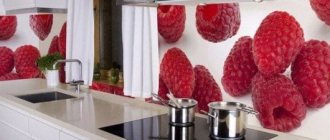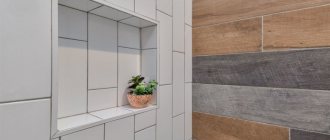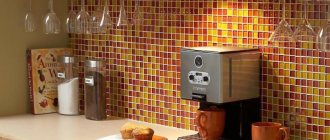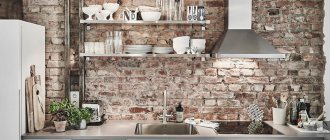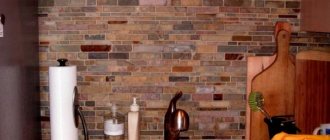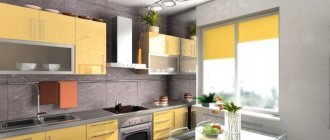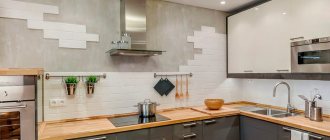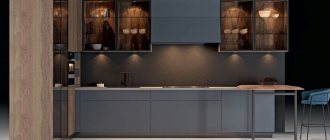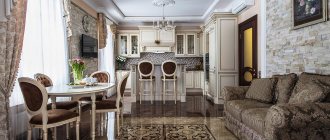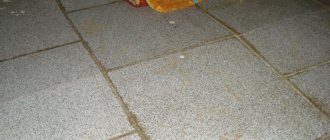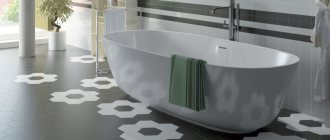Kitchen backsplash tiles are an important decorative element that emphasizes the advantages of the kitchen set and the kitchen as a whole. The variety of modern ceramic tiles will help bring any, even bold design into reality.
The undoubted advantages of kitchen tiles:
- dense with low porosity;
- a huge selection of colors, textures, shapes;
- harmonious combination with other finishing materials and various decorative inserts;
- you can choose an option for any style of kitchen;
- durable and easy to maintain;
- protects walls from moisture and dirt;
- washes well, greasy stains are easily removed;
- tolerates temperature changes well;
- easy installation.
There are not many disadvantages:
- you must have the skills to do the job or invite a professional to do the installation;
- a matte surface is easier to maintain than a glossy one;
- Over time, light grout needs to be renewed.
When choosing an apron for the kitchen, you need to take into account many nuances: the design of the kitchen, the material from which the kitchen tiles are made, the layout of the set itself with all the protrusions, the format of the tiles and the type of cladding.
Dimensions of tiles and backsplash
The height of the apron in the kitchen work area is usually 50-60 centimeters. When choosing the size of the tile, make sure that its height and width are multiples of the height and width of the apron. Then pruning will not be necessary or will be minimal. It is advisable that the apron extends a couple of centimeters under the upper and lower cabinets. It is important to take into account the protrusion under the hood.
- Very popular size: 10*10 cm. Perfect for a small kitchen. It will look harmonious with a small set. Does not require trimming during installation. It is convenient to cover the apron in hard-to-reach places and combine it with other tiles or panels.
- Other sizes are also available for sale. For example, 20x20, 20x30, 30x30, 30x40, 30x60 cm. Laying them is easier and faster, but trimming is often required. Small kitchens are not tiled with large tiles. They visually spoil the interior; the kitchen seems smaller.
- Ceramic bricks or “hog”. This is a tile with beveled edges. Comes in different sizes and colors. Looks great in both modern and traditional kitchens.
- Mosaic is coming back into fashion. Beautiful, but demanding to maintain; skill in working with such complex cladding is required.
- Ceramic blocks with the illusion of a mosaic pattern. The effect is achieved using a convex pattern or deep tile joints, which are filled with grout. Capricious to care for.
- Shapes with embossed edges are used in bold design projects when you want to focus on the apron.
HPL Laminate
Decor of the “Capri” series from the Neapolitan collection (Kerama Marazzi). Photo: Kerama Marazzi
Decor of the “Sorrento” series from the Neapolitan collection (Kerama Marazzi). Photo: Kerama Marazzi
Decor of the Forio series from the Neapolitan collection (Kerama Marazzi). Photo: Kerama Marazzi
A kitchen apron made of high-pressure laminate paper HPL will ideally match the pattern and color of the countertop or kitchen furniture facades. The material is highly resistant to moisture, thermal influences, fat, food acids and detergents. An apron made of this plastic is impervious to UV rays, wear-resistant, easy to care for, and durable. The cost of a panel with a format of 3000 × 600 × 6 mm ranges from 1800 to 5000 rubles. The color option of this material is usually chosen when ordering kitchen furniture. The optimal size will be determined by a professional measurer. To decorate the section of wall between the wall cabinets and the countertop, most often only one panel is required. They install it simultaneously with the installation of kitchen furniture, attaching it to the base with glue.
Photo: ShutterStock/Fotodom.ru
- Kitchen
5 unsuitable materials for a kitchen apron, and how to replace them
What types of styling are there?
- Traditional or simple.
- In a run-up or with a shift.
- Diagonal (you can add a diamond or deck layout here).
- Herringbone.
- Combination (with a different color or size).
- Modular grid (made of slabs of different sizes).
- Chess.
- Complex pattern (for example: kaleidoscope).
The photo below illustrates all the options listed above.
Bottom line
The choice of which type of floor tile is best for kitchens depends on a number of factors, including wall decoration, kitchen furniture, overall design, how many square meters. constitutes the working perimeter. The range of tiles is huge.
The quality and durability of the material to be laid directly depends on its cost.
What should you consider when choosing?
- First you need to decide on the style in which the apron and the kitchen as a whole will be made.
- Indoors, you need to consider lighting as sunlight makes colors brighter and lighter. Indoor lights make colors feel warm, while halogen lights give the feel of cool colors. If the renovation is done on your own, then it is worth familiarizing yourself with the basics of color in order to avoid color overlap (for example, blue shades under indoor yellow light give a green tint).
- Large sizes are suitable for a large kitchen, and accordingly, small ones will look harmonious in a small kitchen.
- The square shape looks familiar and if you want to add originality, it is better to use round, hexagonal, triangular or irregular geometric tiles.
- Light colors visually enlarge the kitchen and allow you to emphasize the furniture, while dark colors visually make the kitchen smaller. Bright contrasting colors draw attention to the apron, and bedding to the furniture.
- A smooth shiny surface will brighten the room, while a matte surface will make the room smaller.
- The contrasting color of the grout will attract attention, and the color of the grout will make the surface visually seamless.
- Tiles for the apron must be purchased with a reserve, adding 5-10% for a simple installation method and 15% - 20% when laying diagonally, combined or in a complex pattern. Also, a reserve is taken in case of a fight, unsuccessful pruning, defects and for the future, if the apron needs to be repaired.
- All materials for covering the apron must be purchased in one batch and in the same shade.
This may also be interesting to read: How to choose floor tiles for the kitchen?
Watch more useful tips on choosing in the video:
Metal
A kitchen apron made of stainless steel, brass, or copper in most cases serves as a natural complement to a metal countertop. This element is stylish and expensive. Cost 1 linear m of finished product starts from 10 thousand rubles. The metal is durable and absolutely hygienic. Among its other advantages: reliability, heat resistance, original appearance, although with a small number of color options.
However, the desire to keep the kitchen in perfect condition will force you to spend a lot of time cleaning the metal surface so that dirt and drops, especially on mirror stainless steel, are not noticeable. An alternative option could be a textured metal surface.
Photo: ShutterStock/Fotodom.ru
Aprons in kitchens of different styles
The choice of tiles is also determined by the style in which the interior is designed. Below in the article for each option there are examples of successful design, as well as ideas for new products and unusual solutions.
Modern style
Trend number one, inspired by nature itself: the effect of natural materials (white or gray veined marble, rough stones, minerals, wood, leather and other interesting textures).
Ceramic parquet is gaining popularity, which will create the presence of wood in the interior in restrained (bleached and gray) shades. Imitation of metal or concrete surfaces is no less popular.
In modern interiors, one of the trends has been the use of black and white, combining them not only in color, but also in texture. Diagonal, checkerboard and herringbone patterns are popular.
Smooth monochromatic tiles with a simple stylized pattern or photo print in the style of the 80s, as well as a 3D effect, creating the illusion of movement and volume will fit perfectly into the interior.
High tech
One of the new products is seamless ceramic tiles, which allow you to reduce or completely eliminate the seam gap. Designers appreciated modern technologies.
Often this style uses ceramics with a metallic sheen or painted to look like metal.
Plain color with geometric edges will fit perfectly into the interior. Black and gray colors emphasize the severity of the style. The cladding should only be carried out by a qualified specialist who can maintain the clarity of the lines, which is so important for this style.
Loft
This style is characterized by raw, rough, rough and matte surfaces, which are ideal for creating the necessary atmosphere. For several seasons now, the fashion for the effect of aged finishes, plaster, concrete surfaces and terracotta brickwork has held its position.
A win-win “hog” will also do.
Such an apron will require special care. Sometimes preference is given to ceramics with an imitation of red-brown or white brick.
An artificially aged surface with scuffs looks very impressive.
Classic
Characterized by simplicity of form, absence of complex lines, muted color. An apron trimmed with ceramic blocks imitating natural stone (marble, granite, travertine, etc.) or classic decors (antique ornaments or delicate panels) will look organic and natural. Traditionally monochromatic neutral shades without decorations. The most commonly used colors are white, milky or beige.
But there are colors such as sand, walnut, cognac, gray. It can be either monochromatic with a light pattern.
It will be interesting to look at artificially aged tiles, as if they have their own history. Particular attention is paid to the food preparation area, under the hood. An addition can be panels or strips with floral or relief patterns, geometric strict or three-dimensional designs, or a pattern of tiles of a different color.
The “runaway” masonry from the “hog”, reminiscent of brickwork, fits very well.
For rooms with low ceilings, the cladding can be done vertically. Another popular technique is to lay out the stripes exactly under each other (in columns), using different shades of the same color. White, beige, black or a calm, rich color will emphasize the sophistication and sophistication of a traditional interior.
Another interesting technique is laying tiles in a herringbone pattern with contrasting color grout on the joints.
A complex mosaic of similar-colored elements will look expensive and elegant, which will undoubtedly enliven the kitchen.
Country, Provence, Scandinavian style
Tiles with a textured surface and uneven edges, imitation of natural stone or old clay tiles are perfect for a backsplash in a rustic-style kitchen. Such a kitchen will be decorated with ceramic panels or ceramics with antique painting. A 5x5 cm ceramic mosaic with decorative inserts or a small mosaic in natural shades will look good.
For a bright kitchen, the classic solution would be to cover the backsplash with white “hog” tiles. Obvious disadvantage: special care for white grout. Sometimes this problem is solved by selecting grout of a darker color, creating contrast.
With contrasting grout
An apron under a patchwork blanket (using the patchwork technique) or Spanish tiles is an excellent design solution.
Many manufacturers offer in their catalogs small-sized ceramic tiles Majolica (tiles, azulejos), which can realize design ideas. Its glaze is painted by hand and then fired at high temperature. Ethnic ornaments will add special charm: Mediterranean, Arabic, African, Japanese, or Indian.
Metlakh tiles make the apron look like a carpet. Has a large selection of shapes and sizes. Stronger than conventional ceramics, but more expensive.
An apron in the Provence style is characterized by the use of a border or frieze in combination with square tiles.
Ceramic panels, which are a picture of one large element or a set of small slabs, are often used in Provence and country styles. The best place is the wall behind the hob, or the food preparation area.
Decorative facing stone
Artificial facing bricks from the “Bruges Brick” and “London Brick” collections (from RUB 837/m²). Photo: White Hills
Artificial stone is an effective and environmentally friendly material. It is non-flammable, tolerates temperature changes and high humidity. Cost of 1 m² - from 850 rubles. Any dirt and dust typical of walls in the kitchen apron area can be easily removed from the surface of the stone cladding with a brush dipped in soapy water. But still, the material does not like frequent contact with water, especially chlorinated water. Additional strength and moisture resistance will be given to it by treatment with a hydrophobic composition, approved for use in residential premises. Installing stone is no more difficult than laying ceramic tiles. Even in shape it resembles it - flat and rough on the back side.
Photo: ShutterStock/Fotodom.ru
- Kitchen
Kitchen apron design (70 photos)
Cladding tips
When tiling the apron, use the following tips.
- Carry out the preparatory work: clear the space around, remove the old finish if necessary, clean, level and prime the surface.
- Take correct measurements, take into account all the nuances and protrusions.
- Attach a metal profile or wooden block to the wall, controlling the horizon using a level.
- The diluted glue does not need to be applied to the entire surface of the apron. Using a spatula, spread the glue and furrow only a few pieces in a row, then it will always be possible to correct it if something goes wrong.
- It is better to use a grout mixture that is waterproof and antifungal.
- The seams must be even, for this we use crosses: for standard laying - four-pointed, for laying in a run - three-pointed.
- Sometimes, for some reason, the drawing may move. This can be corrected by increasing or decreasing the seam.
- Decorative elements are often used when facing aprons. These can be inserts with a flat or relief pattern. Their dimensions must completely coincide with the overall tile in height, width and thickness.
Watch the video for laying tiles:
Glass
The glass apron is usually tempered glass 6 mm thick. It is 5-6 times stronger than normal. Products made from it are fireproof and hygienic. They are difficult to damage with a metal sponge and aggressive cleaning agents. The price of a tempered glass apron depends on the size and starts from 5 thousand rubles. for 1 m². It is increased by the cost of measurement, delivery and installation services. The measurer is called after the furniture is installed. He takes the required measurements and advises on how to attach the apron. To fix it with self-tapping screws around the perimeter of the panel (before hardening), holes are drilled for fasteners, since after hardening the glass cannot be cut or drilled. Fastening with glue is easier, but dismantling such an apron without damaging the glass will not be easy.
Any image can be applied to one side of the glass apron using UV printing. Photo: ShutterStock/Fotodom.ru
Which tile to choose for the kitchen floor: classification of material
The huge assortment that is offered to customers today can easily confuse the buyer with its diversity. All options differ from each other in size, shape, design, as well as technical characteristics.
Helpful advice! If you are not familiar with the material and its characteristics, then it is best to make a purchase in a specialized store, where a sales consultant will be able to answer all your questions and recommend the best option.
Durable kitchen floor tiles
The first thing you should pay attention to before buying kitchen floor tiles is the labeling. Material intended for use as flooring must be marked with a special icon, which depicts a footprint. In addition, floor tiles have a special classification, which is officially adopted in European countries and the USA. Thus, the following types of tiles are distinguished:
- PEI 1 - tiles for wall cladding, which cannot be used as flooring;
- PEI 2 is a tile that can be used as a floor covering for rooms with low traffic - bathrooms or bedrooms, although this type of covering is used quite rarely in living rooms;
Patterned floor tiles
- PEI 3 - floor tiles designed for medium loads, which can be used to decorate any room in the house, with the exception of the hallway;
- PEI 4 is a durable material that can withstand severe loads that it is subjected to as a result of operation on staircases, hallways, etc.;
- PEI 5 is a tile with the highest strength and wear resistance, which is suitable for use in areas with the highest traffic.
Stone-effect floor tiles in the kitchen interior
It is best to buy PEI 3 or PEI 4 class tiles for the kitchen floor, since this is the only way you won’t have to worry about the safety of the coating.
Another important parameter for classifying tiles is its level of safety. This is also an extremely important indicator that you should pay attention to when purchasing. So, the division is made as follows:
- if the coefficient is higher than 0.75, then such tiles are considered safe;
- an indicator from 0.39 to 0.74 is considered a fairly safe material;
- within the range of 0.19-0.39 there is a tile that can be dangerous;
An interesting way to lay ceramic tiles on the floor
- anything below 0.19 indicates an extremely dangerous tile.
Helpful advice! Usually, after washing, tiles become very slippery and can pose a real threat to people's safety. Therefore, it is worth paying attention in advance to such an indicator as slip resistance.
best tiles for kitchen
